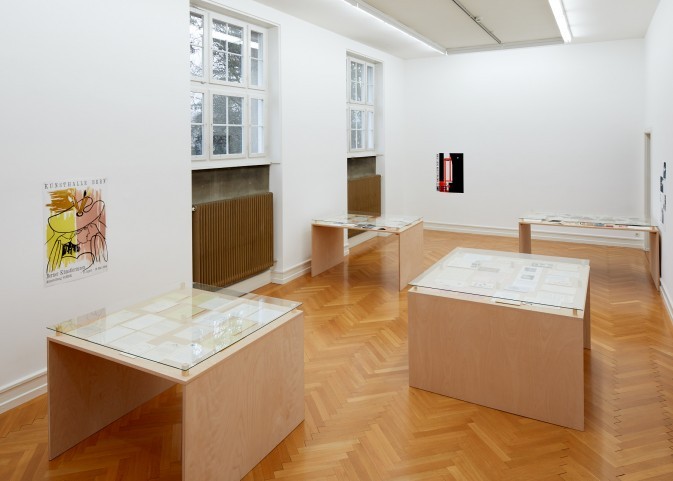Local Dreams
22 Dec 2017 - 04 Feb 2018
LOCAL DREAMS
22 December 2017 – 4 February 2018
Curated by Nicolas Brulhart
Local Dreams is the 3rd successive exhibition dedicated to the archive of Kunsthalle Bern. It forms part of the efforts to enrich historical narratives about and around the institution that are currently taking place in the context of its coming jubilee in 2018. Last year’s exhibition placed the Kunsthalle Bern at the heart of a growing international network of art world protagonists, focusing on the 60s and its, often understood as transformative, media ecology. By contrast, this year’s exhibition lays emphasis on the cultural environment in which the Kunsthalle is located during the Second World War, and looks into how it grows out of this period. The selected documents aim at opening a conversation about the idea of a cultural modernity, appropriated by diverse protagonists – from individual artists to communities to nations.
Digging a layer deeper, one enters into a constellation of actors present during Kunsthalle’s directorship of Max Huggler (1931-1946), Arnold Rüdlinger (1946-1955) and Franz Meyer (1955-1961). But instead of placing the institution in the canon of art history and enquiring mostly about key authorial figures, the exhibition seeks at reintegrating the Kunsthalle Bern in a broader cultural context; presenting documents that appear in relation to the Department of Culture, the culture of modern graphic design, exhibition photographers and the local artistic community. Emerging as central to debates of the period are notions of collectivity, the proximity of crafts to the arts, state endorsed national exhibitions, the pursuit of “Arts of the World” or the instrumentalisation of art for the purpose of education.
Kunsthalle Bern emerges as a site for public debates around cultural modernity. In the exhibition, aspects of its self-representation come to the fore, where the institution deals expressively with the constitution of a here by defining the elsewhere, constructs identity by structuring insides and outsides. Local Dreams suggests a relation to a more popular modernity, one that can appear outdated, a bygone version of the public sphere. This no longer ours echoes recent public tensions and puts the dominant narrative that emerged after the Second World War as well as the consensus on the shaping of a democratic horizon in perspective. By exposing the growing meaning of culture in public discourse of the time, the ambiguous role art plays in the shaping of a modern person becomes accessible. Local Dreams could then also be read as a prelude, before the European launch of the “American Dream”.
22 December 2017 – 4 February 2018
Curated by Nicolas Brulhart
Local Dreams is the 3rd successive exhibition dedicated to the archive of Kunsthalle Bern. It forms part of the efforts to enrich historical narratives about and around the institution that are currently taking place in the context of its coming jubilee in 2018. Last year’s exhibition placed the Kunsthalle Bern at the heart of a growing international network of art world protagonists, focusing on the 60s and its, often understood as transformative, media ecology. By contrast, this year’s exhibition lays emphasis on the cultural environment in which the Kunsthalle is located during the Second World War, and looks into how it grows out of this period. The selected documents aim at opening a conversation about the idea of a cultural modernity, appropriated by diverse protagonists – from individual artists to communities to nations.
Digging a layer deeper, one enters into a constellation of actors present during Kunsthalle’s directorship of Max Huggler (1931-1946), Arnold Rüdlinger (1946-1955) and Franz Meyer (1955-1961). But instead of placing the institution in the canon of art history and enquiring mostly about key authorial figures, the exhibition seeks at reintegrating the Kunsthalle Bern in a broader cultural context; presenting documents that appear in relation to the Department of Culture, the culture of modern graphic design, exhibition photographers and the local artistic community. Emerging as central to debates of the period are notions of collectivity, the proximity of crafts to the arts, state endorsed national exhibitions, the pursuit of “Arts of the World” or the instrumentalisation of art for the purpose of education.
Kunsthalle Bern emerges as a site for public debates around cultural modernity. In the exhibition, aspects of its self-representation come to the fore, where the institution deals expressively with the constitution of a here by defining the elsewhere, constructs identity by structuring insides and outsides. Local Dreams suggests a relation to a more popular modernity, one that can appear outdated, a bygone version of the public sphere. This no longer ours echoes recent public tensions and puts the dominant narrative that emerged after the Second World War as well as the consensus on the shaping of a democratic horizon in perspective. By exposing the growing meaning of culture in public discourse of the time, the ambiguous role art plays in the shaping of a modern person becomes accessible. Local Dreams could then also be read as a prelude, before the European launch of the “American Dream”.

